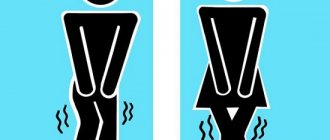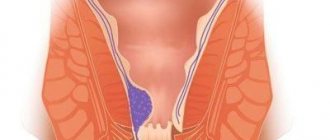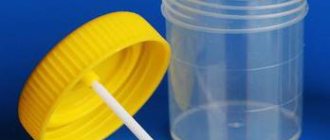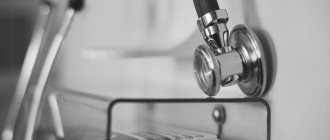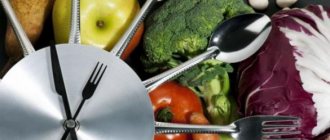1.General information
It would seem that the color of feces is not a topic that needs to be popularized. In a decent society, this is not a topic for discussion at all, and most of us have medical knowledge in this area limited to the axiom “There is no blood - thank God.”
Meanwhile, in medicine there are no indecent topics. For a doctor, like for Sherlock Holmes, every little thing, every nuance or, as in this case, a shade of color matters, since these details can turn out to be diagnostically informative and critically important in solving the main task: having recognized the disease, cure the patient. In this sense, a change in the physicochemical properties of feces is by no means a trifle, but sometimes one of the early, first or even the only (up to a certain point) symptom of a formidable disease. It is necessary to pay attention to the appearance of mucus, plaque, unusual inclusions or clots in the stool, as well as a change in overall color. This does not mean, of course, that if a waste product one day acquires an unusual color, then you need to immediately call an ambulance, but frequent or progressive changes should definitely be a reason for a visit to the doctor.
Any adult understands that the color of feces can normally vary quite widely within the yellow-brown range. This color is explained by the complex biochemical transformations of hepatic bilirubin and, in part, by the composition of the food consumed. Very dark or black tarry stool in most cases is interpreted correctly even by non-specialists - as a possible sign of internal bleeding in the gastrointestinal tract; light or discolored more often only causes bewilderment, although in reality it may turn out to be no less an alarming signal.
A must read! Help with treatment and hospitalization!
Common causes of constipation:
- change in nutritional pattern
- starting kindergarten
- trip with mode change
- hospital stay for any reason
- uncomfortable toilet (outdoors)
Often constipation goes unnoticed at first, especially if the child has already gone to the toilet on his own, falling out of the parent’s control zone. But there is also a kindergarten where parents usually cannot control anything...
As a result, problems are identified already at the stage of constantly soiled panties.
a special visual scale to evaluate stool in a conversation with parents and child :
- Amsterdam AISS Baby Stool Scale for the youngest diaper wearers
- Bristol scale for older children
Children are better oriented using the modified Bristol scale mBSFS (there are only five options instead of seven in the usual adult version).
Another source of confusion is a phenomenon called paradoxical diarrhea : looser stool due to inflammation in the intestine begins to flow around the fecal debris. As a result, parents complain of strange diarrhea, which turns out not to be diarrhea at all, but constipation.
The reasons for non-retentive stool are unclear to doctors, since in such children the volume of the intestine, the sensitivity of the anus, and the speed of feces movement through the colon are normal.
It is very important for the doctor to understand as early as possible the type of calomania - retention or non-retention.
A lot depends on this:
- the prognosis will be different - non-retentive calomasation much more often goes away on its own with age
- There will be different treatments (the most important thing is whether laxatives will help or not)
Here is a table from the International Association for Child and Adolescent Psychiatry and Allied Professions , which compares both types of encopresis and makes life easier for the doctor and the patient.
I would like to draw your attention to ultrasound signs.
Usually, if you have constipation, I almost never refer you for an ultrasound. The technique is good, but not for this situation.
But in some situations, when it is not possible to immediately understand the type of stool, you can send the child for an ultrasound and check the diameter of the rectum.
If the diameter is increased, then this is a clear hint that you cannot do without laxatives.
2. Reasons
Discoloration or lightening of stool can be associated both with the onset of the disease and with relatively harmless reasons. The latter include, first of all, culinary excesses or sharp deviations from the usual diet - for example, consumption of large amounts of dairy products (cottage cheese, sour cream, butter, etc., especially if they are “not from the store,” i.e. they are different
fat content unusual for a city dweller).
The color of stool will naturally change (to light gray) also due to a medical procedure such as an x-ray of the gastrointestinal tract, if barium sulfate was used as a contrast agent. In addition, certain groups of medications can discolor stool, which, when taken more or less long-term, affect liver function, namely:
- anti-inflammatory drugs;
- antimycotics (antifungal drugs);
- oral contraceptives;
- antibiotics;
- anticonvulsants (especially valproate group);
- antipyretics, etc.
Finally, the cause may lie in obvious and serious pathology. First of all, this includes diseases of the liver and biliary tract: hepatitis, cirrhosis, cancer, cholecystitis, obstruction of the bile ducts, etc. Another group of “discoloring” diseases is associated with the pancreas (acute or chronic pancreatitis, oncopathology, infection, irritation with large doses of alcohol). In addition, gross disturbances of digestive processes and, accordingly, changes in the appearance, consistency and color of feces are caused by certain types of food allergies or total intolerance to any product or substance (for example, gluten contained in cereals).
Visit our Gastroenterology page
Steatorrhea
Diagnosis of steatorrhea is carried out by a gastroenterologist and is not difficult, which is explained by the characteristic appearance of feces. The diagnostic search is aimed at a comprehensive laboratory and instrumental examination of the patient in order to detect the causes of the pathological condition. The most informative research methods are:
- Stool microscopy.
For steatorrhea, the detection of drops of neutral fats and fatty acids during scatological examination is pathognomonic. The severity of the syndrome is judged by the number and size of fat droplets: less than 100 inclusions with a diameter of up to 8 microns - average activity, more than 100 large droplets - a severe variant of the disease. - Endoscopic examination.
Retrograde cholangiopancreatography allows you to identify signs of various diseases. The study determines spasm of the sphincter of Oddi, blockage of the bile ducts with stones, narrowing or inflammatory processes in the pancreatic ducts. - Sonography
. Abdominal ultrasound is used to quickly detect pancreatic and biliary pathologies. Ultrasound with steatorrhea may reveal heterogeneity in the structure of the pancreas with alternating areas of hyper- and hypoechogenicity, thickening of the walls of the gallbladder, and gallstones in the ducts. - Secretin-pancreozymin test
. Collection of duodenal contents after intravenous infusion of secretin and pancreozymin is used to assess indicators of exocrine pancreatic function. Functional failure is indicated by a decrease in secretion volume less than 185 ml/h and a decrease in amylase activity.
A general blood test may reveal slight leukocytosis and an increase in ESR. With prolonged steatorrhea, a biochemical blood test reveals significant hypoproteinemia, mainly due to albumin, and dysproteinemia. There is a decrease in the level of basic blood electrolytes (sodium, potassium, calcium, magnesium, iron). For the purpose of non-invasive study of exocrine pancreatic secretion, a breath test with triglycerides labeled with 14C is used.
In case of steatorrhea, it is necessary to carry out differential diagnosis between two main groups of causes of this disease: diseases of the pancreas and biliary system. Pancreatic pathology is indicated by a decrease in enzyme test values, an increase in fecal elastase and ultrasound signs of inflammation of the organ. The main criterion for diagnosing biliary tract pathology is sonographically or radiographically confirmed stones. A hepatologist may be involved in counseling the patient.
3. Symptoms, diagnosis
When independently assessing the situation and deciding what to do, it is very important to analyze the events of the last days: what new, unusual or excess entered the body from the outside. If all factors except food are eliminated by exclusion, we can expect that upon returning to the usual diet, the color of stool and other functional indicators of the gastrointestinal tract will normalize within two to three days without significant disturbances in the general condition. However, it should be remembered that many severe diseases of the liver and biliary (bile) system can also begin with few or asymptomatic symptoms, making themselves felt only by abnormally light-colored feces.
If there is reason to associate the discoloration with taking any medications, this is the very case that the information insert for the drug warns: “contact your doctor immediately” to report this (as well as any other) side effect.
Finally, the presence/absence of additional symptoms is key, even if they are mild or seem unrelated to the gastrointestinal tract. Simultaneously with the lightening or discoloration of stool, the temperature may rise, the urine may darken, heaviness or aching pain in the abdomen may be felt, flatulence, nausea, and aversion to food may appear; The sclera of the eyes and/or skin may turn yellow. In all these cases, especially if there has been any noticeable change in body weight, general health, appetite, appearance, regularity and character of bowel movements recently, you should definitely consult a doctor as soon as possible. At the same time, you shouldn’t rack your brain for a long time about what kind of specialist you need - a gastroenterologist, nephrologist, hepatologist, etc. - start with a therapist, and this generalist doctor will figure out what to do next.
About our clinic Chistye Prudy metro station Medintercom page!
How to determine intestinal disease by stool?
During an appointment with a gastroenterologist, when asked: “How long have you paid attention to the results of the gastrointestinal tract?”, many patients, blushing, look away. It's not shameful!
In our opinion, it is much sadder if you have never looked at your feces. Such observations are a very important method of self-diagnosis and diagnosis in general. The main thing is periodic observation, and not one single look at the stool in the morning before a visit to the doctor.
Changes in stool parameters are one of the main symptoms of most diseases of the intestines and gastrointestinal tract in general.
Indicators to pay attention to when self-diagnosis using stool:
- frequency per day and per week;
- consistency and volume;
- a change in the frequency and consistency of stool, compared to how it was before, when calm and peace reigned in the stomach;
- impurities in feces and its color;
- cases of ineffective or excessive urge to bowel movement;
- lack of urge to defecate or a feeling of incomplete bowel movement.
There is no need to look for a problem where there is none, and you certainly should not turn a blind eye to alarming symptoms. To determine what is normal, it is important to understand that each organism is individual!
Normal stool characteristics
- Frequency - usually 1-2 times per day, 3 to 7 times per week.
- The consistency of the stool, for quick orientation of the patient and the doctor, the Bristol scale, which was published back in 1997, is used. Let's get to know her better. Depending on the diet, the amount of fiber, and water, normal stools can vary from type 3 to type 5.
- Stability of stool, perhaps, has the most difficult explanation: there should be no sudden changes in consistency, frequency of stools during the week, +/- one type on the Bristol scale. The subjective sensation before, during and after the act of defecation is also important. This is a place for satisfaction and quiet joy, I’m quite serious!
- The color of the stool can vary, depending on the diet. Brown of different shades is considered optimal. We make adjustments for the color of food: a lot of dairy products in the diet - the stool will be lighter. Darker if you eat a dish with nori, a black burger. In addition, it is worth thinking about the drugs or dietary supplements that you can take - bismuth and iron preparations give darker, closer to green stools.
Warning symptoms that should not be ignored
- Reduced stools (frequency less than 1 time in 2 days or 3 times a week) or frequent stools (frequency more than 2, occasionally 3 times a day).
- Changes in shape and consistency. We will further get acquainted with the Bristol scale, it is not normal: fragmented, “sheepish” or dense, stool type 1-2 and, in contrast to it, mushy or watery stool, stool with separate flakes - type 6-7.
- Unstable stool - alternation of its consistency and frequency without any pattern, sometimes 1 time a day, sometimes 5, sometimes type 3 on the Bristol scale, sometimes 6. It is also important to notice what sensations accompanied the alternation of stool (good/bad).
- Color change. Pay attention to very light, closer to gray stool or very dark, black stool. Often yellow stools are also a sign of abnormality.
- The appearance of impurities in stool is perhaps the most formidable, but clear symptom:

